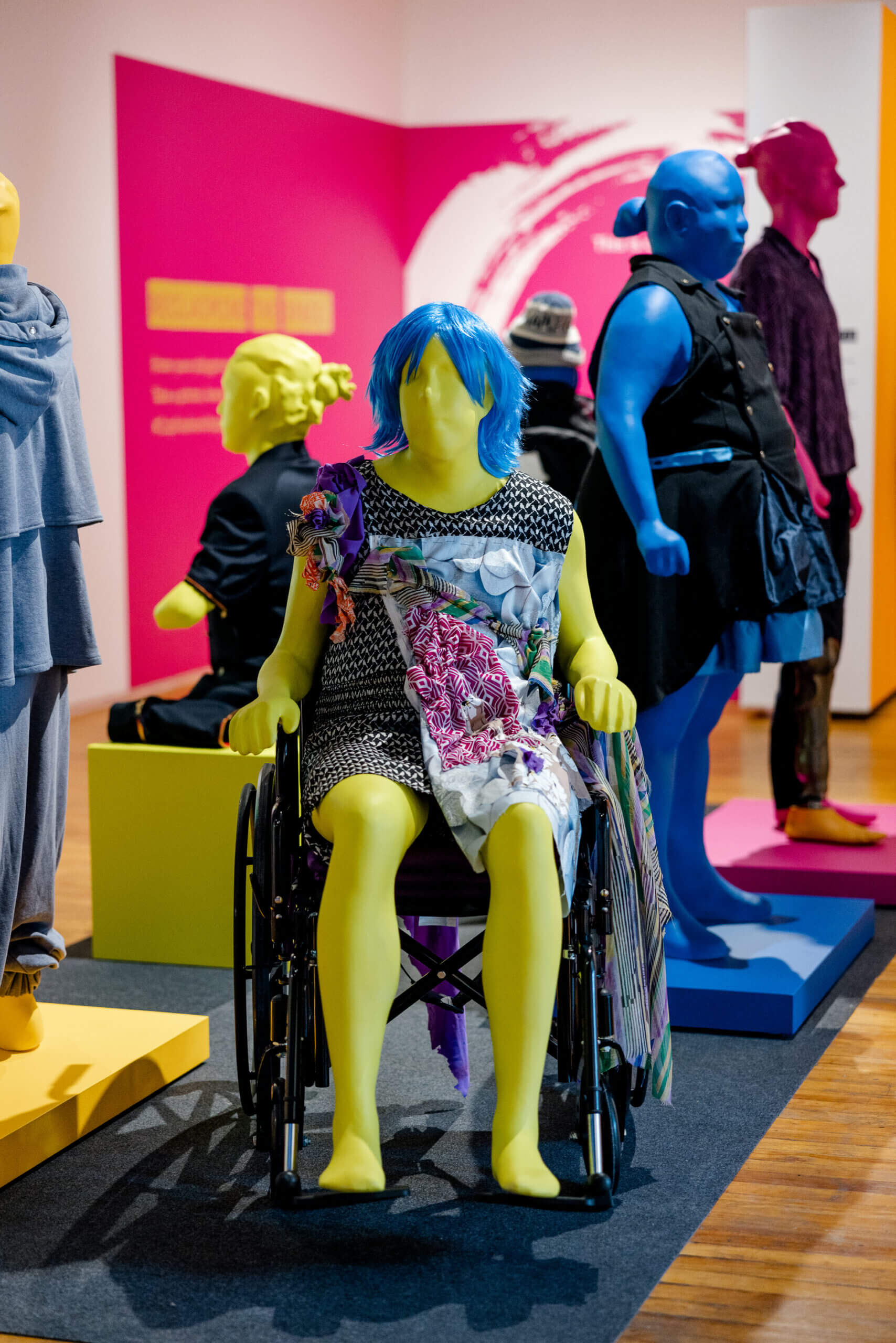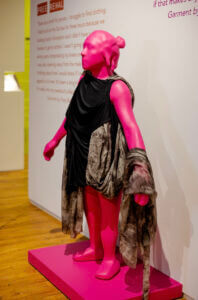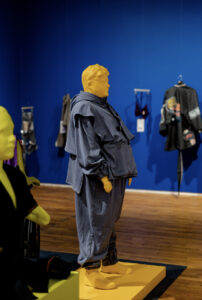Cripping the Script
Queer and disabled people are changing the narrative around masculinity— and making it their own
Tobin Ng

Michelle Peek Photography courtesy of Bodies in Translation: Activist Art, Technology & Access to Life, Re•Vision: The Centre for Art & Social Justice at the University of Guelph.
Fashion spaces have long excluded people who aren’t straight, white, cisgender, able-bodied men. But for many disabled folks, the field also represents opportunity—a place where it’s possible to crip, or challenge through a disability justice lens, dominant understandings of disability and gender.
A new project called Cripping Masculinity explores how disabled men and masculine people build and reimagine their identities through fashion. The project team, which consists of researchers from Toronto Metropolitan University, the University of Alberta, and Parsons School of Design in New York, invited disabled folks to participate in interviews about clothing, outfit creation workshops and a fashion exhibition in Toronto earlier this spring. By interpreting participants’ everyday experiences of dressing as a form of worldbuilding, the project centres the creativity and wisdom of disabled folks as they use fashion to create the communities they want to see.
Tobin Ng caught up with three Cripping Masculinity participants—Sean Lee, Pree Rehal and CX—about notions of masculinity, what a crip utopia might look like, and more.
TOBIN NG: What does cripping the idea of masculinity mean to you?
SEAN LEE: As somebody who grew up visibly disabled and came into their queerness, thinking about crip as a reclaimed term that centres disability made me reevaluate my relationship with my body and my masculinity. Fashion played a big part in how I thought about the ways my body does or doesn’t conform to the ideals and standards that are often emphasized in queer communities, specifically in mainstream gay media. Because I’m queer, disabled and racialized, there are many ways in which my body doesn’t get represented in mainstream fashion.
I really resonate with the way queer and crip folks hack their fashion. They found a way to embrace fashion and own the stares that people give to bodies that don’t conform. I think of it as a form of crip drag or casual guerilla activism. It’s a way to question how bodily difference is taken, accepted or rejected by the mainstream.
 PREE REHAL: Gender is fake, but our socially constructed ideas of masculinity are limited to a very small set of characteristics, especially in the West. Being big and strong and able-bodied is really central to what that looks like. So challenging masculinity is inherently tied to transness and gender diversity. It’s being our authentic selves, and really breaking away from white supremacist ideas of how we’re supposed to look and act.
PREE REHAL: Gender is fake, but our socially constructed ideas of masculinity are limited to a very small set of characteristics, especially in the West. Being big and strong and able-bodied is really central to what that looks like. So challenging masculinity is inherently tied to transness and gender diversity. It’s being our authentic selves, and really breaking away from white supremacist ideas of how we’re supposed to look and act.
For me, it’s also really connected to my inner child. What did I want to wear when I was being told what I had to wear? What did I wish I had when I didn’t have a concept of money, or when I wasn’t able to buy things for myself ?
CX: I’m excited by the concept of cripping masculinity. I love fashion, l love clothes, and I love expressing myself as a crip masculine person. Crip masculinity really speaks to my femme guy style and the ways in which being a femme, transgender non-binary, disabled guy can disrupt and challenge masculinity.
When it comes to fashion, it’s my way of not giving a fuck. It’s about protecting my body, making my body feel well in navigating the world.
TN: What does cripping masculinity look like in your everyday dress?
CX: I’ve started wearing wigs and exploring makeup. I love wearing lots of colour, and that doesn’t feel binary to me—it doesn’t feel masculine or feminine, it feels celebratory. It feels like an expression of myself as a crip person, as a queer person, and as an artist.
As someone who’s read, and sometimes mistreated, as a queer crip guy in the world, I use fashion as a protective force and as a way to express my resilience and fabulousness.
PR: I crip masculinity through the simple act of being. As someone who is autistic, my concept of gender is very loose. I don’t really understand the value of that kind of categorization for myself, and it’s the same thing with sexuality. I self-identify as being trans, non-binary, gender non-conforming, agender, a demiboy—my experiences fall into a lot of different things under the trans umbrella. So anything I do is cripping masculinity, because I’m crip, disabled and transmasc. A lot of times, it looks like cargo pants and sweatsuits, but it’s still that when I’m wearing a tank top and if I decide to wear a dress. It’s inherently anything that I wear.
SL: It changes all the time, and I think that’s part of it—freedom to do what you want. For me, it started off as a way of rejecting the ways in which men’s fashion was so built around a particular type of body. As an artist and curator, I learned about things like crip aesthetics and disability aesthetics, and how they shifted our understanding of perfection and beauty. My fashion sensibility centres around embracing the disruption that disability can bring into a space, and thinking about difference as a generative place to question what we think about aesthetics. There’s so much value in finding different ways of expressing things like gender and sexuality and a crip sensibility.
Long ago, I was wearing a lot of flexible clothing and dresses. Instead of trying to conform the body to a certain ideal, those shapes work with the body, emphasizing aspects of difference in ways that could be interesting and beautiful, or my version of beautiful. As a disabled person, my back curves, my shoulders aren’t even and I’m quite short. A piece of clothing worn by a six-foot model walking down a runway is going to look very different on me. But rather than thinking about clothing as being suited for one particular body, I’ve been trying to see how clothing can adapt to different bodies.
TN: What connections do you see between queer and crip identities?
PR: Something that stood out to me from the Cripping Masculinity project was a conversation I had with a researcher about queer flagging. Back in the day, when homosexuality wasn’t as accepted as it is now, folks would use bandanas or handkerchiefs in specific colours to subtly let others know about their sexualities and preferred positions, and if they were interested in cruising. Today, when you see someone with a carabiner on their belt, you’re like, ‘Oh, maybe they’re queer?’ or ‘That’s somebody who’s a bit fruity.’
With disability, I think there’s a similar kind of signalling we do with our community members to be like, ‘I’m one of you, we’re the same.’ It comes up when you see someone with a cane, or when you hear someone speak and you’re like, ‘Oh, there’s something dyslexic about that,’ or ‘That feels really similar to the way that I talk, think or identify.’ If I see someone at a workshop and they’re using a heating pad, it gives me the idea that they may also experience chronic pain or fibromyalgia. I’m going to go sit with that person as opposed to everyone else that’s sitting upright or in cliques.
SL: For me, crip and queer identity are inherently linked. There’s a disability activist named Mia Mingus who talks about how ableism has to be embedded in our analysis of oppressions, because it upholds the other ways oppression is articulated. An ableist society imagines only one type of body, creating a mythical norm against which other bodies are judged. That norm provides a foundation for other forms of oppression. For example, ableism is used to justify heterosexism by casting queer bodies as undesirable. Recognizing this connection between disability and queerness can help us reject narratives around masculinity and other things we’ve been taught.

CX: My queerness relates to an openness in my body, my sexuality, my gender, and my artistic practice. I enjoy being around the uniqueness of other people in queer, crip communities. It supports how I am. I gain energy and nourishment from uniqueness, and I learn so much.
In that way queer and crip have similarities. My queerness, my gender, my disability are interrelated. As an artist, the art in me is informed by my queerness and my crip identities all at once.
TN: What does a crip utopia look like to you?
CX: I have lots of fantasies of a crip utopia!
A crip utopia for me is visionary, is fantastical. As a visual person with cognitive disabilities, bright colours help me navigate life. Things would be brighter, more colourful, and less boxy. There would be lots of graffiti and colours and animals. Instead of cars everywhere, we would see more wheelchairs and bicycles. Different ways of moving around, different choices.
Our bodies would be celebrated, not defined by or against those who are able-bodied and minded. Disabled people would make greater decisions about where and how we live, and be prioritized in how the world is designed. The people leading society would be disabled, creating crip- friendly places to exist in everyday life—from grocery stores, to living spaces, to streets.
We would all have things to offer. We could cocreate things that are fabulous and wonderful. We could acknowledge our history of being hurt. We wouldn’t be afraid of each other.
I feel love and strength being around people with disabilities. It wouldn’t be such a big deal to be disabled. We wouldn’t only be in communities with other people like us, but we wouldn’t have to hide. Those with and without disabilities would feel empowered to take a lead. We’d be open to mingling with each other. We would be interdependent, naturally. We would offer each other help and support and care without question.
My crip utopia feels very outside of the world we live in right now, which is so directed by a capitalist mindset. This isn’t accessible for crip communities. But anything is possible within my realm of a crip utopia. It’s all about more people being free.
PR: I feel like a crip utopia would look like those memes about artists wanting to go live in a forest or on a farm with their 10 friends. But in reality, when I’ve had the privilege of going on trips with some of my disabled and chronically ill family, something I’ve noticed is that we actually do need a lot of other kinds of considerations and support. So I don’t think living out on a farm would be the best thing for us, because a lot of us can’t really do that kind of labour. But I think some kind of community living that is independent but also interdependent, and doesn’t shut us away from reality would be ideal. I know that crip utopia would definitely be centred around community relations, and it would be led by the most marginalized in our community, and definitely by Black and Indigenous disabled folks.
SL: I love the idea of utopias, because they’re sites of possibility. There’s a queer theorist named José Esteban Muñoz who talked about the idea of queerness as a horizon. It’s this notion that as long as heteronormativity is present, queerness is an ideality. We may never fully be queer, but we can feel this warm illumination of queerness on the horizon. I really think about that application as a crip horizon—elsewhere and elsewhen, as Muñoz would say, in which disability is not only imagined, but embraced and dwelled in.
It’s a complicated horizon because there’s a diversity of disabled folks. There’s so many different ways of thinking about access and how those identities and lived experiences come together with a tenuous throughline to create a whole disability culture. The question is, what’s the culture that can be expressed in the future? The horizon represents a place that we don’t fully know or understand, but one where we can fully be ourselves. And fashion plays such an important part in imagining what that’s like.
We as disabled folks are unruly and noncompliant. We don’t fit into a lot of the structures that have been imagined for only one type of person, that state you have to behave and act in certain ways in order to be part of society. But the idea of a horizon rejects the story of disability as having no place in the future. We’re never going to be at the horizon, just as we’ll never be ‘fully accessible.’ But we’re always moving toward it.
TOBIN NG is a journalist and fact-checker based in Ottawa. Their first magazine byline was in This, and they’ve since written for Xtra, Maclean’s, and Broadview, among other publications. Their stories centre care and creativity in 2SLGBTQ+ and BIPOC communities, exploring how culture and identity shape access to spaces and services.